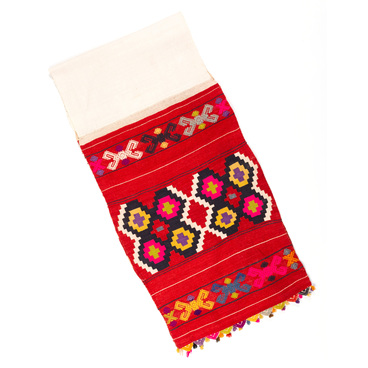Weaving is one of the oldest crafts — it is the process of making a woven fabric from woolen threads, and threads from plant fibers. The fiber obtained as a result of this production process is subsequently used for sewing clothes and other everyday household items.
The most labor-intensive process in the production of fabric is making the thread itself. It consists of obtaining the raw materials — the wool, flax, nettle, and hemp — the lengthy preparation work before spinning, and the spinning itself. Hand spinning is a very long, painstaking process: an experienced craftswoman could spin about 300 meters of yarn from the morning working into the night. The yarn and the flax stripped from the solid parts of the stem — the tow — were first combed and then spun with a treadle wheel, a spinning wheel with a bottom and a spindle. Consequently, it could take up to four days to produce 1 square meter of woven fabric.
Using the twister, the threads located across the length of the fabric that make up the weft were rewound onto a pirn, which is a hollow cylinder made of reeds, or a tube made of birch bark or wood. A twister is a special device that takes the form of a wooden axle with a massive round flywheel — the pirn is put on the pointed, thin end of the axle, while the axle itself is mounted on two posts, which are in turn mounted on a wooden stand that has a hole for the yarn and yarn skeins. Using a stick and a belt, the weaver started to rotate the axis, and the flywheel increased the force of that rotation. Then, while working on the loom, the pirn with the reeled thread was inserted into the shuttle.
Weaving began in the autumn, at the end of the harvest, and people attempted to have it done by the springtime so as not to interfere with the beginning of the new agricultural season. In total, the spinning season lasted for six months, with women spinning and weaving in every peasant house during the autumn and winter days. They learned this craft early on in childhood, and by the age of 16 they had achieved great skill in it. During the autumn and winter, a woman had to weave enough fabric to last the whole family until the next winter, since the entire family wore clothes made with their own hands, and from homespun fabrics.
The most labor-intensive process in the production of fabric is making the thread itself. It consists of obtaining the raw materials — the wool, flax, nettle, and hemp — the lengthy preparation work before spinning, and the spinning itself. Hand spinning is a very long, painstaking process: an experienced craftswoman could spin about 300 meters of yarn from the morning working into the night. The yarn and the flax stripped from the solid parts of the stem — the tow — were first combed and then spun with a treadle wheel, a spinning wheel with a bottom and a spindle. Consequently, it could take up to four days to produce 1 square meter of woven fabric.
Using the twister, the threads located across the length of the fabric that make up the weft were rewound onto a pirn, which is a hollow cylinder made of reeds, or a tube made of birch bark or wood. A twister is a special device that takes the form of a wooden axle with a massive round flywheel — the pirn is put on the pointed, thin end of the axle, while the axle itself is mounted on two posts, which are in turn mounted on a wooden stand that has a hole for the yarn and yarn skeins. Using a stick and a belt, the weaver started to rotate the axis, and the flywheel increased the force of that rotation. Then, while working on the loom, the pirn with the reeled thread was inserted into the shuttle.
Weaving began in the autumn, at the end of the harvest, and people attempted to have it done by the springtime so as not to interfere with the beginning of the new agricultural season. In total, the spinning season lasted for six months, with women spinning and weaving in every peasant house during the autumn and winter days. They learned this craft early on in childhood, and by the age of 16 they had achieved great skill in it. During the autumn and winter, a woman had to weave enough fabric to last the whole family until the next winter, since the entire family wore clothes made with their own hands, and from homespun fabrics.



